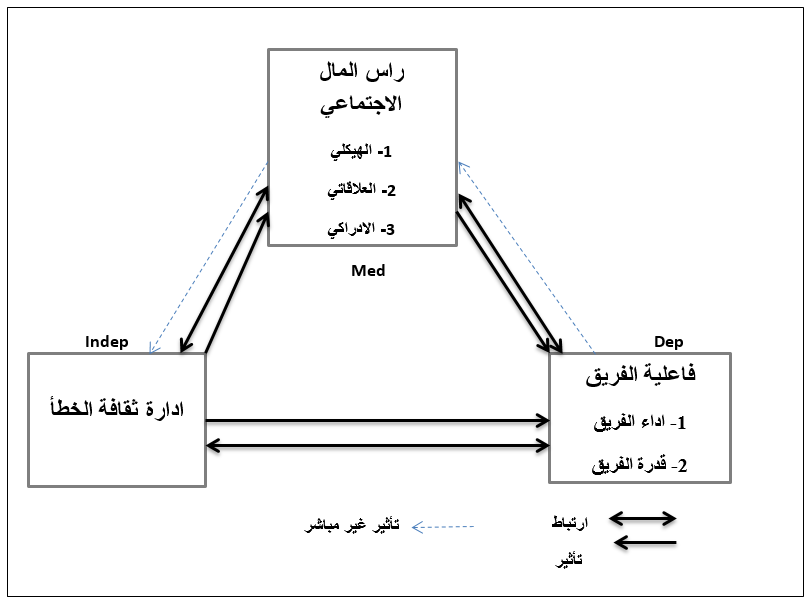Organizational Error Management Culture and Team Effectiveness : The Mediating Role of Social Capital
دراسة استطلاعية لآراء عينة من المهندسين في محافظة كربلاء .
Keywords:
culture of organizational error, social capital, team effectiveness, error management, the local administration of the city of KarbalaAbstract
This research seeks to explore the role of social capital in explaining the relationship between organizational error management culture and team effectiveness through a sample of (114) engineers working within (8) different specialized departments in the local governorate of the holy city of Karbala. And a measurement tool was used that was prepared in the light of previous studies for data collection. The research includes three main hypotheses related to the correlation and influence relations between the research variables. In order to test these hypotheses, a set of statistical tools was used with the help of the statistical program SPSS V.25 and also the JASP program, The researcher reached a set of conclusions, the most prominent of which was the existence of a positive relationship between the organizational error management culture and team effectiveness. as well as the results show that social capital mediates the relationship between the organizational error management culture and team effectiveness. And it is necessary for the senior management to pay more attention to working on spreading an organizational culture in how to deal with mistakes that occur in the work environment because of its impact on the effectiveness of the team as well as strengthening social capital.
References
سعيد , سناء عبد الرحيم , اركان عبد الله ردام , 2017 , تأثير راس المال الاجتماعي في التمكين الهيكلي للعاملين بحث تطبيقي في مديرية بلدية السماوة , مجلة العلوم الاقتصادية والادارية , العدد 103 , المجلد 24 , الصفحات 78-101 .
Adler PS, Kwon S-W (2002) Social capital: Prospects for a new concept. Academy of Management Review 27(1): 17–40.
Afolabi, O.A., Adesina, A., & Aigbedion, A. (2009). Influence of team leadership and team commitment on teamwork and conscientiousness. Journal of Social Sciences, 21(3), 211–216.
Andrews, R. (2010). Organizational social capital, structure and performance. human relations, 63(5), 583-608.
Appelbaum, S. H., Hébert, D., & Leroux, S. (1999). Empowerment: power, culture and leadership–a strategy or fad for the millennium?. Journal of Workplace Learning.
Aube, C., & Rousseau, V. (2005). Team goal commitment and team effectiveness: the role of task interdependence and supportive behaviors. Group Dynamics: Theory, Research, and Practice, 9(3), 189.
Azmy, N. (2012). The role of team effectiveness in construction project teams and project performance.
Bell, B. S., & Kozlowski, S. W. (2008). Active learning: effects of core training design elements on self-regulatory processes, learning, and adaptability. Journal of Applied psychology, 93(2), 296.
Carmeli, A., Gelbard, R., & Reiter-Palmon, R. (2013). Leadership, creative problemsolving capacity, and creative performance: The importance of knowledge sharing.Human Resource Management, 52(1), 95-121.
Chillarege, K., Nordstrom, C., & Williams, K. (2003). Learning from our mistakes: Error management training for mature learners. Journal of Business and Psychology, 17, 369–385.
Choi, S. B., Kim, K., & Kang, S. W. (2017). Effects of transformational and shared leadership styles on employees' perception of team effectiveness. Social Behavior and Personality: an international journal, 45(3), 377-386.
Cusin, J., & Goujon-Belghit, A. (2019). Error reframing: studying the promotion of an error management culture. European Journal of Work and Organizational Psychology, 28(4), 510-524.
Daniel, J. L. (2010). The effect of workplace spirituality on team effectiveness. Journal of management development.
Dewberry, C. (2004). Statistical methods for organizational research: Theory and practice. Psychology Press.
Dimitrova, N. G., Van Hooft, E. A., Van Dyck, C., & Groenewegen, P. (2017). Behind the wheel: What drives the effects of error handling?. The Journal of social psychology, 157(6), 658-672.
Dyer, C. (2018). The Power of Company Culture: How any business can build a culture that improves productivity, performance and profits. United Kingdom, Kogan Page Publishers.
Frese, M., & Keith, N. (2015). Action errors, error management and learning in organizations. Annual Review of Psychology, 66, 661–687.
Guchait, P., Lei, P., & Tews, M. J. (2016). Making teamwork work: Team knowledge for team effectiveness. The Journal of psychology, 150(3), 300-317.
Guchait, P., Paşamehmetoğlu, A., & Lanza-Abbott, J. (2015). The importance of error management culture in organizations: The impact on employee helping behaviors during service failures and recoveries in restaurants. Journal of Human Resources in Hospitality & Tourism, 14(1), 45-67.
Guchait, P., Paşamehmetoğlu, A., & Madera, J., (2015). Error management culture :impact on cohesion, stress, and turnover intentions. The Service Industries Journal, 36(3-4), 124-141.
Guchait, P., Zhao, X., Madera, J., Hua, N., & Okumus, F. (2018). Can error management culture increase work engagement in hotels? The moderating role of gender. Service Business, 12(4), 757-778.
Hackman, J. R., & Morris, C. G. (1975). Group tasks, group interaction process, and group performance effectiveness: A review and proposed integration. Advances in Experimental Social Psychology, 8, 45-99.
Hagen, J., 2013. Confronting Mistakes: Lessons from the Aviation Industry When Eisenberger, R., Stinglhamber, F., 2011. Perceived organizational support: fostering enthusiastic and productive employees. Am. Psychol. Assoc.
Hair Jr, J. F. (2006). Black, WC/Babin, BJ/Anderson, RE & Tatham, RL (2006): Multivariate Data Analysis. Auflage, Upper Saddle River.
Hayes, A. F., & Scharkow, M. (2013). The relative trustworthiness of inferential tests of the indirect effect in statistical mediation analysis: Does method really matter?. Psychological science, 24(10), 1918-1927.
Helmreich, R. & Merritt, A. (2017). November. 11 Safety and error management: The role of crew resource management. In Aviation Resource Management: Proceedings of the Fourth Australian Aviation Psychology Symposium: v. 1: Proceedings of the Fourth Australian Aviation Psychology Symposium. United Kingdom, Routledge.
Hofmann, D. A., & Frese, M. (Eds.). (2011). The organizational frontiers series (SIOP).Errors in organizations. Routledge/Taylor & Francis Group.
Jung, H. S., & Yoon, H. H. (2017). Error management culture and turnover intent among food and beverage employees in deluxe hotels: the mediating effect of job satisfaction. Service Business, 11(4), 785-802.
Katzenbach, J. R., & Smith, D. K. (2015). The wisdom of teams: Creating the highperformance organization. Boston: Harvard Business Review Press.
Khan, I. Y. (2020). The Impact of Shared Leadership on Team Effectiveness, in Project Teams, with Mediating Role of Trust and Moderated by Project Team Commitment (Doctoral dissertation, CAPITAL UNIVERSITY)
Kim, H., Stoner, M., 2008. Burnout and turnover intention among social workers: effects of role stress, job autonomy and social support. Adm. Soc. Work 32 (3), 5–25.
Kozlowski SW, Ilgen DR. 2006. Enhancing the effectiveness of work groups and teams. Psychol. Sci. Public Interest 7:77–124.
Leenders, R. T. A., Gabbay, S. M., & Fiegenbaum, A. (2001). Corporate social capital and the strategic management paradigm: a contingency view on organizational performance. Research School Systems, Organisation and Management.
Lin, N. 2001. Building a network theory of social capital. In N. Lin, K. S. Cook, & R. S. Burt (Eds.), Social capital: Theory and research: 3-30. New Brunswick, NJ: Transaction Publishers.
Mahembe, B., & Engelbrecht, A. S. (2014). The relationship between servant leadership, organisational citizenship behaviour and team effectiveness. SA Journal of Industrial Psychology, 40(1), 1-10.
McGrath, J. E. (1964). Social psychology: A brief introduction. New York: Holt, Rinehart, & Winston.
Nahapiet, J., & Ghoshal, S. (1998). Social capital, intellectual capital, and the organizational advantage. Academy of management review, 23(2), 242-266.
Nakagawa, Y., & Shaw, R. (2004). Social capital: A missing link to disaster recovery. International Journal of Mass Emergencies and Disasters, 22(1), 5-34.
Nordstrom, C. R., Wendland, D., & Williams, K. B. (1998). “To err is human”: An examination of the effectiveness of error management training. Journal of business and psychology, 12(3), 269-282.
Payne, G. T., Moore, C. B., Griffis, S. E., & Autry, C. W. (2011). Multilevel challenges and opportunities in social capital research. Journal of management, 37(2), 491-520.
Preacher, K. J., & Hayes, A. F. (2008). Asymptotic and resampling strategies for assessing and comparing indirect effects in multiple mediator models. Behavior research methods, 40(3), 879-891.
Putnam, R. D. (2000). Bowling alone: The collapse and revival of American community. Simon and schuster.
Reason, J., 1990. Human Error. Cambridge university press.
Ross, T.M., Jones, E.C., & Adam, S.G. (2008). Can team effectiveness be predicted? Team Performance Management, 14(5/6), 248-268 http://dx.doi.org/10.1108/13527590810898518
Schneider, B., Ehrhart, M.G., Macey, W.H., 2013. Organizational climate and culture. Annu. Rev. Psychol. 64, 361–388.
Seibert, S. E., Kraimer, M. L., & Liden, R. C. 2001. A social capital theory of career success. Academy of Management Journal, 44: 219-237.
Shepherd, D. A., Patzelt, H., & Wolfe, M. (2011). Moving forward from project failure: Negative emotions, affective commitment, and learning from the experience. Academy of Management Journal, 54(6), 1229-1259.
Srivastava, K., & Das, R. C. (2015). Human capital management: Economics of psychological perspective. Industrial psychiatry journal, 24(2), 115.
Su, K., Lee, Y., & Tsai, Y. (2005). The paradigm of knowledge acquisition and social capital in engineering education: empirical research from Taiwanese universities. World Transactions on Engineering and Technology Education, 4(1), 93-98.
Tsai, W. 2000. Social capital, strategic relatedness and the formation of intraorganizational linkages. Strategic Management Journal, 21: 925-940.
Tsai, W., & Ghoshal, S. (1998). Social capital and value creation: The role of intrafirm networks.Academy of Management Journal, 41(4), 464-476.
Vadakel, R. T., & Sankaran, K., 2005, Dimensions of Social Capital and New Expectations from Knowledge Management Tools , Compendium of Research Papers , Faculty, TAPMI , 32-40.
Van Dyck, C., Frese, M., Baer, M., Sonnentag, S., 2005. Organizational error management culture and its impact on performance: a two-study replication. J. Appl. Psychol. 90 (6), 1228.
Wang, Danni, David A. Waldman, and Zhen Zhang. "A meta-analysis of shared leadership and team effectiveness." Journal of applied psychology 99.2 (2014): 181.
Wang, X. H. F., Fang, Y., Qureshi, I., & Janssen, O. (2015). Understanding employee innovative behavior: Integrating the social network and leaderemember exchange perspectives.Journal of Organizational Behavior, 36(3), 403- 420.
Wang, X., Guchait, P., & Pasamehmetoglu, A. (2020). Anxiety and gratitude toward the organization: Relationships with error management culture and service recovery performance. International Journal of Hospitality Management, 89, 102592.
West, M.A. (2004) Effective Teamwork—Practical Lessons from Organizational Teamwork. 2nd Edition, Blackwell, USA.
Woehr, D. J., Arciniega, L. M., & Poling, T. L. (2013). Exploring the effects of value diversity on team effectiveness. Journal of Business and Psychology, 28(1), 107-121.

Downloads
Published
How to Cite
Issue
Section
License
Copyright (c) 2024 College of Administer and Economics - Kerbela University

This work is licensed under a Creative Commons Attribution-NonCommercial-NoDerivatives 4.0 International License.
Authors retain the copyright of their papers without restrictions.









